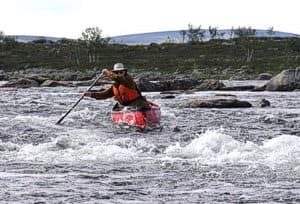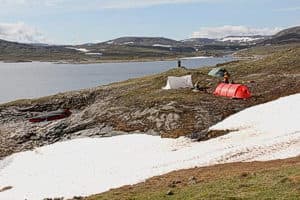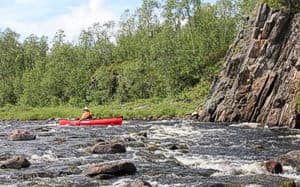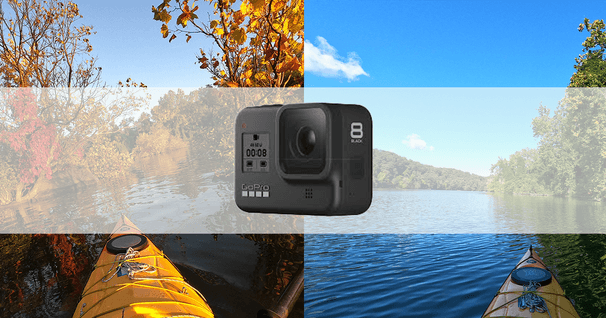Miracle Boats
When Alv Elvestad, owner of Pakboats (www.pakboats.com) invited me to join him and three friends on a canoe trip in his native land, Norway, I was thrilled. After all, I'd done the Canadian shtick for decades; it was time for something new. Alv proposed a trip of around 100 miles on three connecting (with portages) rivers - the Poroeno, Lataseno and Kautokeino - with a mid-route cross-over into Finland (no passport control; just scoot under the reindeer fence!).
Alf said the route was extremely remote (wilderness canoeing is largely a curiosity in Scandinavia) and advised that "…paddlers should be competent in technical Class III rapids that may run for miles!" Alv had done most of this route years ago, but in tandem canoes. This time, we four would use solo PakCanoes: three 15-footers and one 14-footer for the little guy - me.

Alv brought an untried canoe: a Darth Vader-black experimental 15-footer which weighed 38 pounds - about 6 pounds less than standard. He said that if the lightweight fabric held up, it might eventually find its way into the Pakboat line. Every boat carried a repair kit, but these were never used. We didn't put a single hole in any of these canoes.
Our put-in was a high tundra lake located 200 miles north of the Arctic Circle and a four hour drive from Alv's boy-hood home in Storslett near the Finish border. The final leg required us to ascend a tortuous Class IV gravel road to the top of a mountain. In the U.S., this road would be marked for dedicated 4-wheel drive vehicles only. But in Norway, 4WD's are as uncommon as coo-coo birds (hey, we actually saw some of them on our trip!) and are replaced instead with two-wheel drive know-how. Tore, Alv's brother, didn't blink when driving his diesel Mercedes Benz station wagon and snowmobile trailer packed with canoes and gear, right to the top of the mountain. Bets were made that he couldn't turn the rig around at the put-in. Wrong! In less than a minute the Benz was headed home.
Our put-in was a high tundra lake located 200 miles north of the Arctic Circle and a four hour drive from Alv's boy-hood home in Storslett near the Finish border. The final leg required us to ascend a tortuous Class IV gravel road to the top of a mountain. In the U.S., this road would be marked for dedicated 4-wheel drive vehicles only. But in Norway, 4WD's are as uncommon as coo-coo birds (hey, we actually saw some of them on our trip!) and are replaced instead with two-wheel drive know-how. Tore, Alv's brother, didn't blink when driving his diesel Mercedes Benz station wagon and snowmobile trailer packed with canoes and gear, right to the top of the mountain. Bets were made that he couldn't turn the rig around at the put-in. Wrong! In less than a minute the Benz was headed home.


In Canada, a barren lands trip usually begins in the tree-line then descends to the tundra. In Norway, it's the other way around. So for the first few days there was no wood for campfires and we cooked exclusively on a gasoline stove. By day three, scraggly trees appeared and we built fires every night.
Our route was highlighted by near continuous rapids, punctuated by frequent dragging, occasional lining and more portages. Lining here is more meticulous than in Arctic Canada where shorelines tend to be clear of vegetation. Twenty-five foot lines are usually long enough on a Canadian river. Not so in Norway where trees (big trees!) grow right to the water's edge. I scoffed when Alv suggested 50 foot lines. I'm glad I took his advice!
Our starting elevation was 3000 feet; the take-out at the Sami town of Kautokeino (900 feet). Average drop for the 100-mile route was 20 feet per mile. Our most notorious rapid on the Poroeno River, was a mile long and dropped over 60 feet. It rated a heart-throbbing technical Class III and there was just one resting eddy along the way. No one made a clean run, and there was a lot more excitement waiting for us downstream!
Rocks were often just a meter apart and clearing them required strong leans, braces and 90-degree turns. Fortunately, our boats turned instantly, like pure-bred slalom canoes. Again and again we slammed full-steam into rocks, occasionally broaching on them, then going waist deep in the flow to save the day. Admittedly, I have become a klutz in my old age and thus had wet feet nearly every day. My friends, with their usually dry feet, took frequent occasion to poke fun at my misfortune.
Tired of dragging and grounding on rocks, we embraced a new policy:
"Just give us some water to paddle - damn the drops! Clear channel ahead? Take it!"
We began to run bigger and bigger drops. Ahead is a four foot ledge. Over we go. The bow breaks upward to create more rocker. Our canoes run nearly dry -- maybe a gallon of water gets in. Amazing! A hard boat this size would swamp and sink. We were so stunned by the durability of these canoes and their competence in rapids that we began to call them "miracle boats".
On his Pakboats.com website, Alv Elvestad makes a strong case for the portability of these canoes. Disassembled and bagged, they ride easily in an airplane, bus or car. But I would beg the high note of durability and whitewater performance as their first prize. In the Piragis Northwoods Company catalog (www.piragis.com) I am quoted as saying that these canoes are, "Much more durable than any hard boat I've paddled." Now, I would underline and add emphasis to that statement! But more importantly, when loaded with two weeks of camping gear, they handled big complicated rapids better than any similarly-sized hard boat I've paddled. They run nearly dry in big rapids, even without a spray cover because the hull creates additional rocker as it rises to the waves. Another plus is that when the hull broaches on a rock, it bends slightly around the rock and creates a more streamlined shape to the current. This results in less force on the hull which makes the hull easier to dislodge from the rock.

I had a couple of close capsizes on this trip but none materialized. I don't think I would have been so fortunate in a hard boat. Pakboats are also lighter than equivalent-sized hard boats, and in the unlikely event you hole one, they can be repaired in less than 10 minutes with the supplied repair kit, even in cold weather.
These Pakboats really are "miracle canoes". I just can't say enough good things about them.
Cliff Jacobson is a professional canoe guide and outfitter for the Science Museum of Minnesota, a wilderness canoeing consultant, and the author of more than a dozen top-selling books on camping and canoeing. www.cliffcanoe.com
Related Articles
~A Paddler's Post submitted by Gregg Jackson~ For decades I had combined the joys of hiking and…
Dane Jackson, one of the top whitewater kayakers in the world, drops a 130+ ft waterfall in Chile. He is…
Guaranteed: After watching this video you will want to go look at flight prices to Norway.
I once asked the late Verlen Kruger what he valued most on a wilderness canoe trip. "My comfort!" he…



